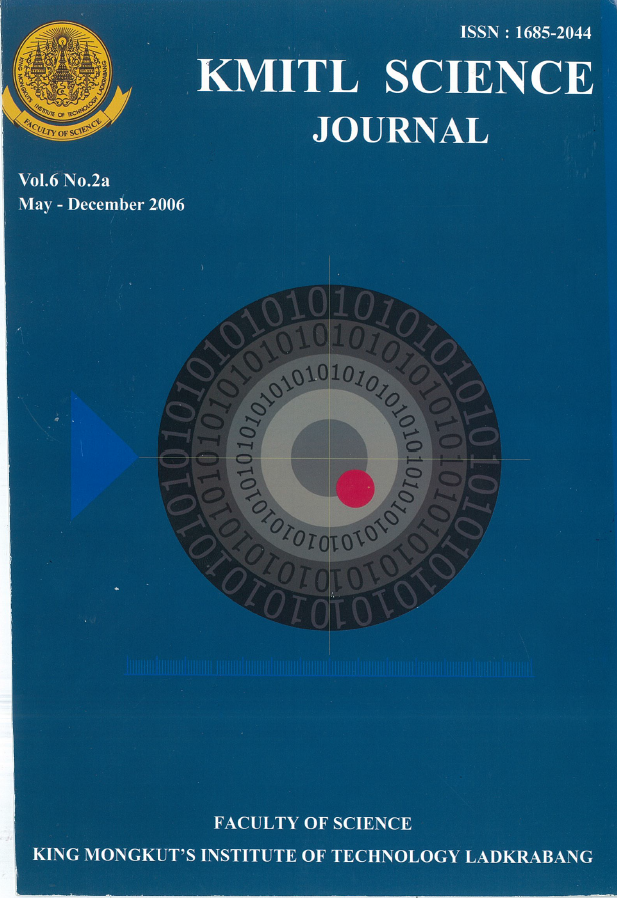Medicine Tablets Identification Using Feature Extraction Based on Neutral Network
Main Article Content
Abstract
The purpose of this research is to develop medicine tablet identification method by using an image recognition system. The algorithm consists of three main stages: (i) preprocessing and segmentation (ii) feature extraction (iii) image classification. In the first stage, the images of the medicines are cropped. Then, we use Canny’s algorithm to detect edges from the images. After that in the second stage, 3 groups of features: shape features (perimeter, area, compactness, radius, standard derivation of radius), color features and internal tablet features are extracted from the medicine tablet images. In the last stage, we apply feed-forward backpropagation neural network to classify different groups of shape features. With these outputs, we compare and select the group of features that give the best classification. Finally, medicine tablet images are identified by using output from the neural network and observing color and internal tablet features.
In the experiments we used 33 types of medicine, 20 tablets for each type which were digitized in 2 dimensions: front and back for each tablet. Each type of medicine was divided to 2 groups: training and testing groups equally. The proposed method yields maximum 99.39% total accuracy.
Keywords: Medicine Tablet Identification, Feature Extraction, Neural Network
Corresponding author: E-mail: jara838chan@yahoo.com, jaravee_ch@ccpe.or.th
Article Details
Copyright Transfer Statement
The copyright of this article is transferred to Current Applied Science and Technology journal with effect if and when the article is accepted for publication. The copyright transfer covers the exclusive right to reproduce and distribute the article, including reprints, translations, photographic reproductions, electronic form (offline, online) or any other reproductions of similar nature.
The author warrants that this contribution is original and that he/she has full power to make this grant. The author signs for and accepts responsibility for releasing this material on behalf of any and all co-authors.
Here is the link for download: Copyright transfer form.pdf
References
[2] www.http://www.pharmacycouncil.org/html/htmlexpand/standard01.html
[3] Castleman, K.R. 1996 Digital Image Processing. Englewood Cliffs, N.J., Prentice-Hall.
[4] www.http://marathon.csee.usf.edu/edge/edge_detection.html
[5] www.http://homepages.inf.ed.ac.uk/rbf/HIPR2
[6] www.http://people.westminstercollege.edu/students/djb0331/CMPT300/Project/Project Discussion.html
[7] www.http://www.ccs.neu.edu/home/mtrubs/html/EdgeDectection.html
[8] Geradts, Z.J., Hardy, H., Poortman, A., and Bijhold, J. 2001 Evaluation of Contents-Based Image Retrieval Methods for a Database of Logos on Drug Tablets. Proceedings SPIE, Wuhan, China, pp.553-562.
[9] www.http://www.personal.psu.edu/users/d/u/dus150/Documents/papersd.doc
[10] Intharasombat, O. 2003 Mammographic Masses Classification Using Active Contour Models and Shape Features. Proceedings 7th NCSEC, Chonburi, Thailand, pp. 265-270.
[11] www.http://damato.light-speed.de/Irecog/
[12] Mitzias, D.A. and Basil G.M. 2004 a Neural Multiclassifier System for Object Recognition in Robotic Vision Applications, Imaging Measurement systems 36(3-4), 315-330.
[13] Zhang, M. 1997 A Pixel-Based Approach to Recognizing Small Objects in Large Pictures Using Neural Networks. Proceedings of Annual RMIT Computer Science Postgraduate Students Conference, Melbourne, Australia, pp. 57-68.
[14] www.http://www.ii.metu.edu.tr/~ion528/demo/lectures/6/4/index.html
[15] www.http://www.pages.drexel.edu/~weg22/can_tut.html
[16] Canny, J.F. 1986 A Computational Approach to Edge Detection, IEEE Trans. Pattern Analysis and Machine Intelligence 8(6), 679-698.
[17] Pratt, W.K. 2001 Digital Image Processing: PIKS Inside. 3rd Edition, California, John Wiley & Sons, Inc.
[18] www.http://www.uoguelph.ca/~mwirth/cis6320.htm

